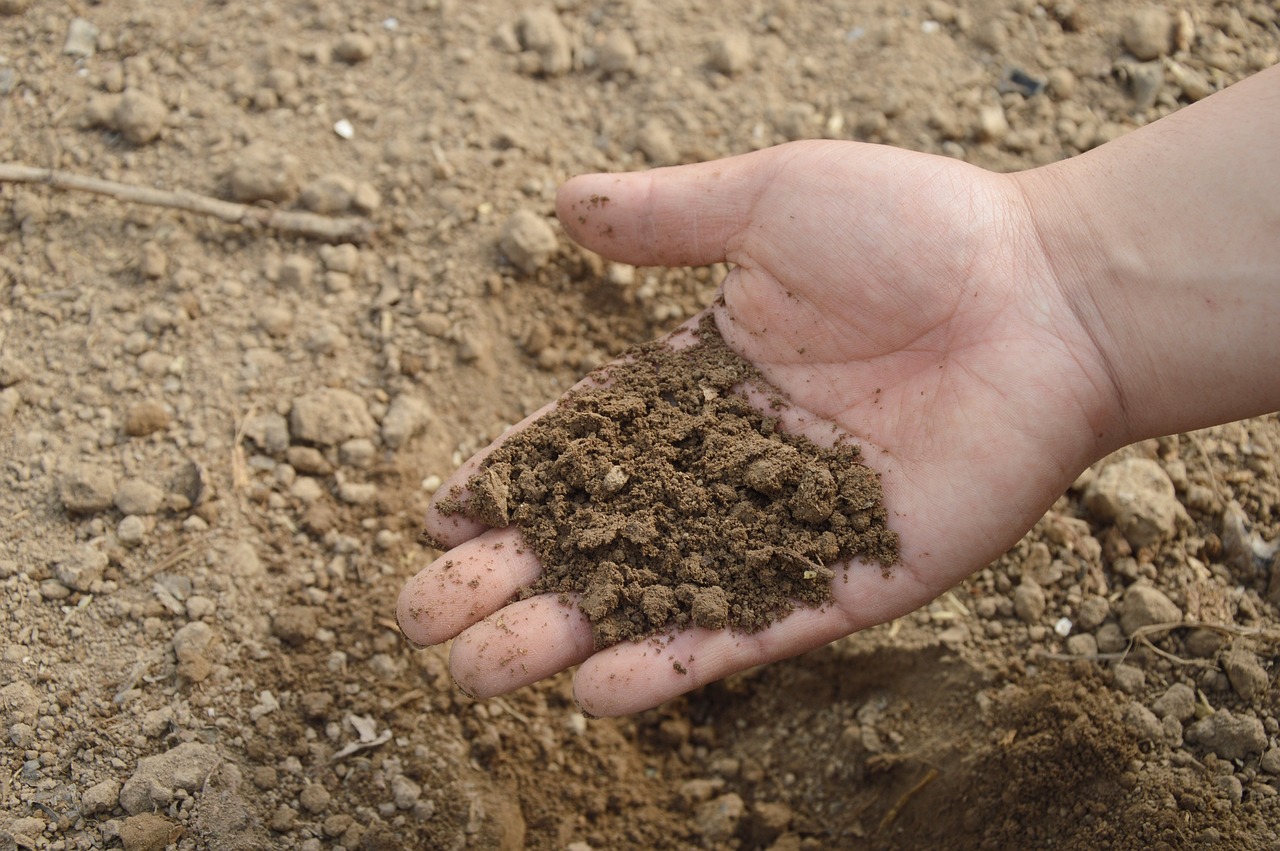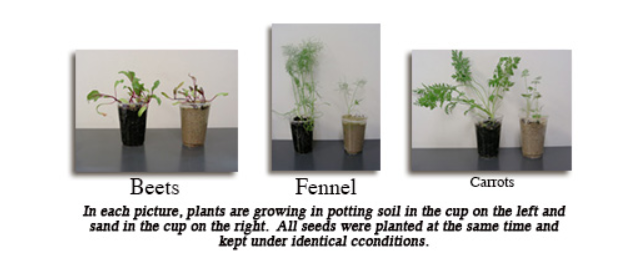Properties of Soils (Grades 3-5)
Students discover that different soils have different characteristics, examine different types of soil, investigate soil components, and observe how air space allows soils to hold and transmit water.

Background
Lesson Activities
Recommended Companion Resources
Credits
Author
Nutrients for Life Foundation
Acknowledgements
- BSCS-Biological Science Curriculum Study
- Reviewed by Smithsonian Institution
Standards
Texas Content Area Standards
-
ELA: 4.110.6.b.1
Developing and sustaining foundational language skills: listening, speaking, discussion, and thinking- oral language. The students develops oral language through listening, speaking, and discussion.
- ELA: 4.1.D: The student is expected to work collaboratively with other to develop a plan of shared responsibilities.
-
ELA: 5.110.7.b.1
Developing and sustaining foundational language skills: listening, speaking, discussion, and thinking- oral language. The students develops oral language through listening, speaking, and discussion.
- ELA: 5.1.C: The student is expected to give an organized presentation employing eye contact, speaking rate, volume, enunciation, natural gestures, and conventions of language to communicate ideas effectively.
- ELA: 5.1.D: The student is expected to work collaboratively with others to develop a plan of shared responsibilities.
-
Science: 3.112.14.b.2
Scientific investigation and reasoning. The student uses scientific practices during laboratory and outdoor investigations.
- Science: 3.112.14.b.2.B: The student is expected to collect and record data by observing and measuring using the metric system and recognize differences between observed and measured data.
- Science: 3.112.14.b.2.E: The student is expected to demonstrate that repeated investigations may increase the reliability of results.
-
Science: 3.112.14.b.7
Earth and space. The student knows that Earth consists of natural resources and its surface is constantly changing.
- Science: 3.112.14.b.7.A: The student is expected to explore and record how soils are formed by weathering of rock and the decomposition of plant and animal remains.
-
Science: 4.112.15.b.2
Scientific investigation and reasoning. The student uses scientific practices during laboratory and outdoor investigations.
- Science: 4.2.B: The student is expected to collect and record data by observing and measuring, using the metric system, and using descriptive words.
- Science: 4.2.F: The student is expected to communicate valid oral and written results supported by data.
-
Science: 4.112.15.b.7
Earth and space. The student knows that Earth consists of natural resources and its surface is constantly changing.
- Science: 4.7.A: The student is expected to examine properties of soils, including color and texture, capacity to retain water, and ability to support the growth of plants.
-
Science: 5.112.16.b.2
Scientific investigation and reasoning. The student uses scientific practices during laboratory and outdoor investigations.
- Science: 5.2.A: The student is expected to describe, plan, and implement simple experimental investigations testing one variable.
- Science: 5.2.C: The student is expected to collect and record information using detailed observations and accurate measuring.
- Science: 5.2.F: The student is expected to communicate valid conclusions in both written and verbal forms.
-
Social Studies: 3.113.14.c.14
Social studies skills. The student applies critical-thinking skills to organize and use information acquired from a variety of valid sources, including technology. The student is expected to:
- Social Studies: 3.113.14.c.14.C: interpret oral, visual, and print material by sequencing, categorizing, identifying the main idea, distinguishing between fact and opinion, identifying cause and effect, comparing, and contrasting
-
Social Studies: 3.113.14.c.15
Social studies skills. The student communicates in written, oral, and visual forms. The student is expected to:
- Social Studies: 3.113.14.c.15.D: express ideas orally based on knowledge and experiences
-
Social Studies: 4.113.15.c.19
Social studies skills. The student applies critical-thinking skills to organize and use information acquired from a variety of valid sources, including technology. The student is expected to:
- Social Studies: 4.113.15.c.19.C: analyze information by applying absolute and relative chronology through sequencing, categorizing, identifying cause-and-effect relationships, comparing, contrasting, finding the main idea, summarizing, making generalizations and predictions, and drawing inferences and conclusions;
-
Social Studies: 4.113.15.c.21
Social studies skills. The student communicates in written, oral, and visual forms. The student is expected to:
- Social Studies: 4.113.15.c.21.C: express ideas orally based on research and experiences
-
Social Studies: 5.113.16.c.23
Social studies skills. The student applies critical-thinking skills to organize and use information acquired from a variety of valid sources, including technology. The student is expected to:
- Social Studies: 5.113.16.c.23.C: analyze information by applying absolute and relative chronology through sequencing, categorizing, identifying cause-and-effect relationships, comparing, contrasting, finding the main idea, summarizing, making generalizations and predictions, and drawing inferences and conclusions
-
Social Studies: 5.113.16.c.25
Social studies skills. The student communicates in written, oral, and visual forms. The student is expected to:
- Social Studies: 5.113.16.c.25.C: express ideas orally based on research and experiences
-
Science: 3.112.5.b.1
Scientific and engineering practices. The student asks questions, identifies problems, and plans and safely conducts classroom, laboratory, and field investigations to answer questions, explain phenomena, or design solutions using appropriate tools and models. The student is expected to:
- Science: 3.112.5.b.1.E: collect observations and measurements as evidence
-
Science: 3.112.5.b.3
Scientific and engineering practices. The student develops evidence-based explanations and communicates findings, conclusions, and proposed solutions. The student is expected to:
- Science: 3.112.5.b.3.B: communicate explanations and solutions individually and collaboratively in a variety of settings and formats
-
Science: 3.112.5.b.10
Earth and space. The student knows that there are recognizable processes that change Earth over time. The student is expected to:
- Science: 3.112.5.b.10.B: investigate and explain how soils such as sand and clay are formed by weathering of rock and by decomposition of plant and animal remains
-
Science: 4.112.6.b.1
Scientific and engineering practices. The student asks questions, identifies problems, and plans and safely conducts classroom, laboratory, and field investigations to answer questions, explain phenomena, or design solutions using appropriate tools and models. The student is expected to:
- Science: 4.112.6.b.1.E: collect observations and measurements as evidence
-
Science: 4.112.6.b.3
Scientific and engineering practices. The student develops evidence-based explanations and communicates findings, conclusions, and proposed solutions. The student is expected to:
- Science: 4.112.6.b.3.B: communicate explanations and solutions individually and collaboratively in a variety of settings and formats
-
Science: 5.112.7.b.1
Scientific and engineering practices. The student asks questions, identifies problems, and plans and safely conducts classroom, laboratory, and field investigations to answer questions, explain phenomena, or design solutions using appropriate tools and models. The student is expected to:
- Science: 5.112.7.b.1.B: use scientific practices to plan and conduct descriptive investigations and use engineering practices to design solutions to problems
- Science: 5.112.7.b.1.E: collect observations and measurements as evidence
-
Science: 5.112.7.b.3
Scientific and engineering practices. The student develops evidence-based explanations and communicates findings, conclusions, and proposed solutions. The student is expected to:
- Science: 5.112.7.b.3.B: communicate explanations and solutions individually and collaboratively in a variety of settings and formats
